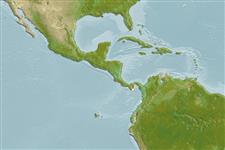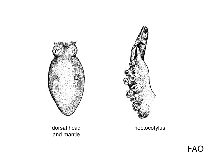Euaxoctopus panamensis Voss, 1971
Crescent octopus| Native range | All suitable habitat | Point map | Year 2050 |

|
| This map was computer-generated and has not yet been reviewed. |
| Euaxoctopus panamensis AquaMaps Data sources: GBIF OBIS |
Классификация / Names народные названия | синонимы | CoL | ITIS | WoRMS
Cephalopoda | Octopoda | Octopodidae | Octopodinae
Environment: milieu / climate zone / пределы глубины / distribution range экология
; пределы глубины 0 - 50 m (ссылка 83938). Tropical
Distribution страны | регионы FAO | Ecosystems | места находок | интродукции
Eastern Central Pacific: Colombia, Costa Rica and Panama.
Length at first maturity / Size / Weight / Возраст
половая зрелость: Lm ? range ? - ? cm Max length : 20.0 cm TL самец/пол неопределен; (ссылка 96968)
Life cycle and mating behavior половая зрелость | размножение | нерест | Eggs | Fecundity | Larvae
Основная ссылка
ссылки | координатор | соавторы
Hochberg, F.G. and Y.E. Camacho-García 2009 Squids and octopuses. p. 399-408 Wehrtmann, I.S.; Cortés, J. 2009. Marine biodiversity of Costa Rica, Central America. Springer 538pp. (ссылка 83938)
Статус Красного Списка МСОП
(ссылка 130435: Version 2025-1)
Статус СИТЕС (ссылка 108899)
CMS (ссылка 116361)
Угроза для людей
Использование человеком
| FishSource |
инструменты
дополнительная информация
состав пищи
потребление пищи
хищники
Max. ages / sizes
Length-weight rel.
Length-length rel.
Размерный состав
Mass conversion
численность
ресурсы в Интернет
BHL | BOLD Systems | CISTI | DiscoverLife | FAO(Publication : search) | Fishipedia | GenBank (Геном, Нуклеотид) | GloBI | Gomexsi | Google Books | Google Scholar | Google | PubMed | Tree of Life | Wikipedia (Вперёд, поиск) | Zoological Record



